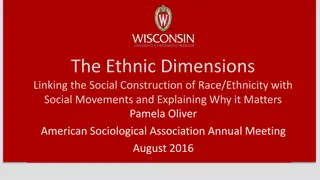Understanding Ethnicity and Ethnic Conflicts
The concept of ethnicity involves both primordial and constructivist perspectives, with primordialists viewing it as an inherited identity and constructivists as a social construct based on fictive kinship. Perceived differences among ethnic groups can lead to conflicts, often rooted in historical events and the need to preserve distinct identities. Ethnic identity may have emerged to replace lost ties to traditional kinship groups disrupted by modernization processes.
Download Presentation

Please find below an Image/Link to download the presentation.
The content on the website is provided AS IS for your information and personal use only. It may not be sold, licensed, or shared on other websites without obtaining consent from the author. Download presentation by click this link. If you encounter any issues during the download, it is possible that the publisher has removed the file from their server.
E N D
Presentation Transcript
Ethnicity and Ethnic Conflicts Basic terms and theory
What is ethnicity? Ethnicity (= ethnic identity) according to Primordialists: Ethnicity is a type of identity inherited in a mind of every human being. Ethnic groups are thus a universal way of differentiation of mankind and exist in unchangeable manner since time immemorial. Primordial = having existed from the beginning, in an earliest or original stage. Similar approach is maintained by Essentialists: Behavior of the group is persistent, deeply irrationally emotional, passionate, spontaneous , like organic entity. These approaches ( hard ) are widely spread in public discourse (schools, media, politics) but they are supported by very few scholars.
Constructivist (ethnicity context) /Instrumentalist (ethn. conflict context) approach ( soft ): Ethnic identity is a social identity characterized by fictive kinship which is constructed in relation to others . Fictive kinship is usually composed of: 1) perceived cultural differences between groups (cultural unity of the group stands for real proximity of blood) and 2) myths of common origin (stands for a real family ancestor).
Myths of common origin are usually constructed by cultural collective memory , i.e., canonical interpretation of historical events by official historians (mainly in school education), emphasizing unchanged continuity of the nation and struggling with some other .
Why perceived differences? Some ethnic groups are very similar in terms of culture but due to historical reasons they developed as distinct ethnic groups (e.g. Serbs and Croats). Therefore, they have to emphasize one ethnic element (e.g. religion) and diminish other (e.g. language). Or they have to exaggerate some element that in fact almost does not exist (it is often a case of culturally assimilated ethnic minorities). D. Horowitz (p. 18): Cleavage drives culture more than culture drives cleavage. On the other hand, there are significant cultural differences between groups as well as within groups but if the groups do not constitute different ethnic identities from historical reasons the differences do not stand as ethnic boundary markers.
Ethnic identity was invented to replace lost ties to rural-kinship primary groups which were interrupted by modernization processes (urbanization, industrialization etc.) Ties to primary groups ( Gemeinschaft ) are extremely important for psychological wellbeing (maybe evolutionary conditioned). Thus, there was an urgent need for identity which could simulate and evoke them in wider masses of individualized workers ( Gesellschaft ).
It was a typical process in Europe since late 18th century (to this day in some cases). However, ethnic identity can develop also in agricultural non-Western societies without breaking away from primary groups when there is a need to create a strong collective identity in a large group. Elements of modernization are often used in this process (unified education, standardized language, mass media, communication technologies, means of transport etc.)
Does ethnic identity produce an ethnic group in a strong sense (i.e. externally bounded, internally homogenous group, a community)? No. Once it appears it usually establishes only ethnic category in a long term, i.e., cognition/knowledge of belonging to/ being labeled as a member of some ethnic group. In other words, it produces identification as/with somethnig (people are identified as Hungarians etc.).
Ethnic category is not established for ever (it can disappear like popular interwar idea of Czechoslovak nation ) but it is usually fostered by state (if there is any) through institutional structure (state institutions, schools etc.) so that one can hardly forget about it. Ethnic category can also be prepared for population whose members do not feel any ethnic identity (ethnically indifferent, e.g. some Roma). It is done by ethnic discourse of other population and/or it is an effect of specific historical group naming (connected to race, language, profession, religion, caste etc.).
Members of an ethnic group can feel a different intensity of ethnic identity (= different groupness, commonality) in different time since it is a socially constructed phenomenon. It can decline to almost zero intensity (atomized individuals) and raise again to a high intensity (intensive solidarity and strong ties ), depending on social circumstances (namely change of relationships to other groups).
Ethnic identity is usually just one of many identities (identifications) that modern Europeans feel (identify with). Ethnicity Profession and interest Social class Religion 11
Ethnic identity is usually surpassed by other stronger - identities (it may change according to situational social context) human christian mother adherent of conservative party Czech 12
Ethnic identity can be almost negligible (it may change according to situational social context) crew member sprayer hip hopper high-school student Prague local 13
Ethnic Conflict - definition Brubaker and Laitin (p. 428): Ethnic violence is perpetrated across ethnic lines, in which at least one party is not a state (or a representative of a state), and in which the putative ethnic difference is coded by perpetrators, targets, influential third parties, or analysts as having been integral rather than incidental to the violence, that is, in which the violence is coded as having been meaningfully oriented in some way to the different ethnicity of the target.
Ethnic Conflict - definition Another typical definiton but less useful for the region in focus of our course: Shale Horowitz (p. 913): A war between a dominant ethnic group affiliated with the state, and a geographically concentrated outsider ethnic group located within the state s borders, over rival claims to territory and political self-determination. (p. 915) It should involve sustained, organized fighting led by elites with significant resources, as opposed to more limited elite-level clashes, one-sided predations, or mass-level rioting.
Ethnic Conflict instrumentalist (soft) approach Conflicts that are framed as ethnic usually did not begin as struggles between the whole sharply bounded groups but as calculated projects of certain actors willing to achieve political power to gain resources. The ethnic groups had to be gradually (re)created for the purpose of the conflict. Even when the groups are created and fully involved into conflict there are still particular actors to be found behind it (political entrepreneurs, parties, organizations, media etc.), because the groups themselves cannot act as an organism.
Ethnic Conflict primordial/essential (hard) influence However, Instrumentalists do not pay enough attention to emotional and irrational factors in ethnic conflicts: 1) Why do ethnic activists and political entrepreneurs ( catalysts ) use ethnic and not any other identity as a basis for their projects ? 2) How come that there are factors in conflicts (resentment, fear etc.) independent on the will of the conflict-mongers?
1) Ethnic identity is usually much stronger than any other identity of large groups (secondary groups) because it evokes features of primary group (i.e., fictive kinship).
2) Emotions like fear and hatred are so strong and deep in our mind (see faces at the picture below) that once stirred they become factors independant on catalysts . Thus, catalysts start a vicious circle in which it can be hardly recognized what is cause and what is effect. Lake & Rothschild (p. 55): ethnic activists and political entrepreneurs are as much a product as a producer of ethnic fears
2) Other irrational elements had often already existed before the catalysts began to operate: resentments (suppressed strong emotions based on perceived status inequality of groups in society and historical stereotypes).
Scenario of ethnic conflict (type: anti-Roma riots) A trigger (sudden migration, teenager fight etc.) mass media coverage arrival of outside conflict professionals and/or political entrepreneurs (right- wing extremists etc.) entrapment of inexperienced local politicians defining a scapegoat (ethnic minority) mobilizing local population employment of religion or racism to dehumanize enemy (and glorify in-group members) in order to harm/kill them easily The weaker the state, the stronger and more violent the conflict.
Scenario of ethnic conflict (type: Jugoslavian wars) Strategic dilemmas: information failures problems of credible commitment security dilemma (incentives to use force preemptively)























